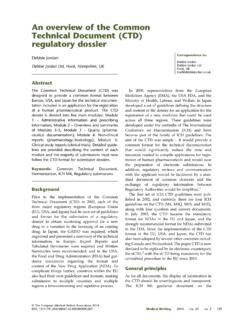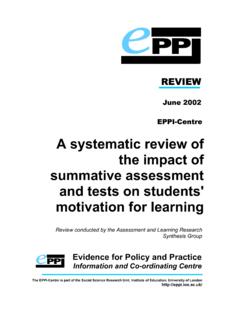Transcription of Writing narrative style literature reviews - EMWA
1 Writing narrative style literaturereviewsCorrespondence to:Rossella FerrariFreelance medical writer,Milan FerrariMilan, ItalyAbstractReviews provide a synthesis of published literatureon a topic and describe its current in clinical research are thus useful whendesigning studies or developing practice two standard types of reviews are (a) systematicand (b) non-systematic or narrative review. Unlikesystematic reviews that benefit from guidelinessuch as PRISMA (Preferred Reporting Items forSystematic reviews and Meta-Analyses) statement,there are no acknowledged guidelines for narrativereviews. I have attempted to define the best practicerecommendations for the preparation of a narrativereview in clinical research. The quality of a narrativereview may be improved by borrowing from the sys-tematic review methodologies that are aimed atreducing bias in the selection of articles for reviewand employing an effective bibliographic researchstrategy.
2 The dynamics of narrative review Writing ,the organizational pattern of the text, the analysis,and the synthesis processes are also : narrative review, Systematic review,Search methodology, Review writingIntroductionA periodic synthesis of knowledge is requiredbecause of the huge amount and rapid rate of pub-lications. The need for a review of literature mayarise from the abundance of information, divergentviews, or a lack of consensus about a ,2 Although synthesizing the literature is a challengingtask, the interest in reviews is ever-growing. Unlikeoriginal articles, literature reviews do not presentnew data but intend to assess what is already pub-lished,3,4and to provide the best currently availableevidence. For this reason a review is defined as a secondary research study, meaning that it isbased on primary research two standard types of reviews are (a) sys-tematic (SR) and (b) non-systematic or narrativereview (NR).
3 NRs are aimed at identifying andsummarizing what has been previously published,avoiding duplications, and seeking new studyareas not yet ,5,6 While PRISMA(Preferred Reporting Items for Systematic Reviewsand Meta-Analyses) provides reporting guidelinesfor SRs, no acknowledged guidelines are availablefor NR Writing . The task of review Writing is fre-quently assigned to medical writers, for example,on new or completed research projects, synthesisfor editorial projects. However, training opportu-nities on Writing literature reviews in the biomedicalfield are few. The objective of the present study is toidentify practice guidelines to improve NR writingon topics related to clinical of narrative andsystematic styles of literature reviewsA recent report stated that NRs form the basis ofmedical literature synthesis, and their number peryear in MEDLINE significantly surpassed that NRs and SRs differ in objectives,methods, and application areas, both may includeseveral kinds of studies with different levels of evi-dence: randomised clinical trials, observationalcase-control or cohort studies, and case , since NRs and SRs are written retro-spectively, both are prone to main objective of a SR is to formulate a well-defined question and provide a quantitative andqualitative analyses of the relevant evidence, fol-lowed or not by a meta-analysis.
4 The SR strengthsare: focus on a unique query, clarity in retrievingarticles for review, objective and quantitativesummary, and inferences based on , SRs have several limitations: hetero-geneity in the selected studies, possible biases ofsingle studies (patients selection, performanceevaluation, measurement), and even ,10 Moreover, SRs cannot be continuouslyupdated; the median validity of an SR has been esti-mated as years, but it is 3 years for 23% ofreviews and 1 year for 15%, depending on the230 The European Medical Writers Association 2015 DOI: ,11 According to some reports onSRs, significant shortcomings of SRs were the lackof: assessment of biases, reporting of key methodo-logical aspects, especially in non-Cochrane SRs,12and inclusion of adverse of collecting data for SRs can be compli-cated, for example, if the patient and disease charac-teristics are not well reported,7and it might bedifficult to draw conclusions that would be appli-cable in daily practice.
5 Moreover, there are norules regarding the sample size contrast to SRs, NRs can address one or morequestions and the selection criteria for inclusion ofthe articles may not be specified in study selection is the main weaknessascribed to NRs that potentially leads to NR is irreplaceable to track the develop-ment of a scientific principle or clinical concept; asin fact, the narrative thread could be lost in the restric-tive rules of a SR; some issues require the widerscoping of a NR. On the other hand, the rigour ofan SR is needed to evaluate, for example, the efficacyof diagnostic or treatment interventions, and the out-comes of natural or therapeutic are the key sources of evidence, their technicallanguage and the time needed to identify the keyresults may deter their 1 sum-marizes the hallmark differences between NRs reality, neither the SRs with their restrictedfocus, nor the NRs with their distinctiveness com-pletely satisfy the wide range of topics to , new approaches are currently in develop-ment such as meta- narrative reviews15and the need for an NR is identified,a glance at the expert opinions on this particulartopic may be useful in improving the method of lit-erature selection and reducing the risk of a subopti-mal of a narrative reviewAs yet there is no consensus on the standard struc-ture of an NR.
6 The preferred format is the IMRAD(Introduction, Methods, Results, Discussion), butan NR may be organised in a chronological order,with a summary of the history of a research whenclear trends are identified, or presented as a concep-tual frame , where the contents are separatedaccording to dependent or independent variablesand their ,17 However, the NRs struc-ture should respect, apart from the author prefer-ences, the journal style , and the conventionsfollowed in the particular field. Table 2 visualizesthe general framework of an NR. In this model thecentral body is partitioned in units (sections), eachcomposed by concepts (key variables), which arediscussed and searchUnlike SRs, the Methods section is not mandatoryfor NRs (depending on the journal style ), but ifincluded, it adds clarity to the key messages of ,18 20 The literature search (the Methods )isa critical step in determining the selection bias.
7 Ifthe review query is well-defined, for example, aclinical question, then it would be possible todesign an appropriate search strategy in a form suit-able for search engines. Hence, a structuredapproach on the lines of that used for SRs is advisa-ble in literature search for 1: Main differences between narrative and systematic reviewsNarrative reviewsSystematic reviewsMain FeaturesDescribe and appraise published articles but themethods used to select the articles may not query is well defined [review question, secondaryquestion(s) and/or subgroup analyses].Clearly defined criteria for the selection of articles from methods of extraction and synthesis of the research to find all the relevant of standards for the critical appraisal of thestudies General debates, appraisal of previous studies andthe current lack of , assess and synthesize the literature gathered inresponse to a specific for future what is known about a topic and identify the basis ofthat on new types of interventions available.
8 Comprehensive report with explicit processes so thatrational, assumptions and methods are open toexamination by external assumptions and the planning are not scope is limited by the defined query, search terms, andthe selection criteriaSelection and evaluation biases not reader needs to reformulate the alternative questionsthat have not been answered by the main Writing narrative style literature reviews231 Medical termsAs the search terms (keywords) define the limits andthenatureoftheliteraturesearch,theses houldbeestablished in a comprehensive way in order topermit selection of all the related articles, and at thesame time, eliminate those that are not relevant. Thekey concepts are transformed into keywords, choosingonly the most distinctive ,18 Thesaurus systemssuch as the MeSH (Medical Subject Headings) termsof the National Library of Medicine, which are usedto index articles for PubMed, may be referred to forselecting the appropriate keywords directly relatedto the topic of ,3,18 Selection criteriaDefining the inclusion/exclusion criteria for litera-ture selection can be helpful in focusing on the rel-evance of the studies to the topic.
9 The exclusioncriteria may be identified according to the perti-nence of the search objective, whereas the inclusioncriteria may define the fundamental factors of the first step it is useful to mark the date, key-words, and their combination with the number ofrecords retrieved during each search. The processmay continue selecting manually other publicationsthat are cited in the articles retrieved during the firstsearch. Then the cycle can be repeated till reaching a saturation point .17It is advisable to include a variety in the infor-mation sources, for example consult differentdatabases, and limit citations of the same researchgroup or the same journal, even though these maybe articles are preferableover other NRs on the same topic. In addition toreports of randomized clinical trials and observa-tional studies, editorials by key opinion leadersmay also be a primary bulk of articles is obtained, theselection may be refined and process may berecorded in a Summary table or using Referencecards.
10 18it is useful to sort the articles and filethese with the bibliographic references in an appro-priate citation assessmentEvaluating the fitness of an article for the reviewmay prove to be a complex task that concerns differ-ent issues related to the journal, author s(s ) repu-tation, accuracy of methods, analysis general, each article should be criti-cally evaluated according to the following:3 key results limitations suitability of the methods used to test the initialhypothesis quality of the results obtained interpretation of the results impact of the conclusions in the fieldThe studies with the best contributions should besynthetized3highlightingthepossibleTab le 2: General framework of narrative reviewsIntroduction Content: describe the rationale Structure: organization of the collected information Limits: define the objective(s) and scopeLiterature search Searching strategy: databases, keywords Inclusion/exclusion criteria: types of studies, languages, time periods, others Verify the availability of all the selected studies Citing and listing the researched referencesCentral body/Discussion:Section 1 Section 2 Added sectionsFirst key concept:Another key concept: discuss and evaluate summarize in relation to the research query discuss and evaluate summarize in relation to the research query following the same patternConclusionsFrom each summarised section: highlight the main points connect with the research needs repeat the meaning for the research designAbstract According to the journal style Descriptive or structured (IMRAD pattern)Ferrari Writing narrative style literature reviews232 Medical among the results.








